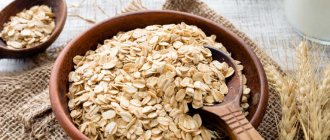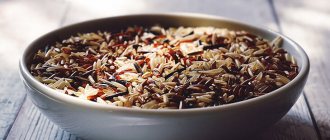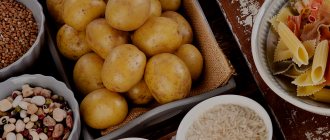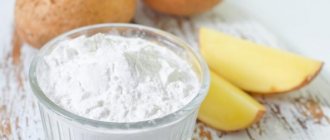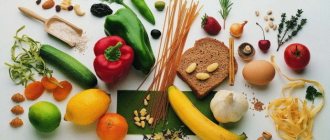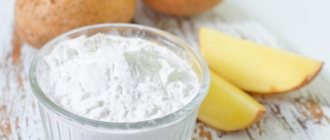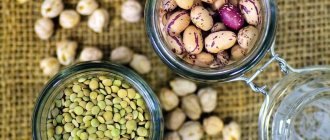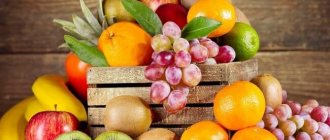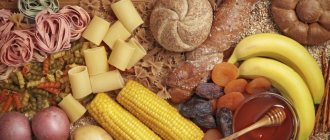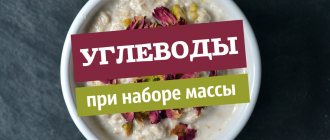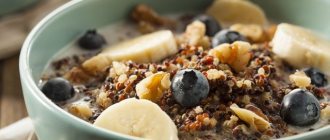Beneficial features
Since ancient times, people began to add cereals (derivatives of various grain crops) to their diet. The Greeks and Romans served barley, and in Rus' at that time it was customary to eat oats and millet. Then people intuitively understood that porridge was the easiest way to get enough food and regain strength and energy.
Cereals have unique properties and nutritional value. Typically, per 100 g of porridge there is:
- 50 kcal;
- carbohydrates – 11 g;
- proteins – 1.4 g;
- fats - 0.2 g;
- potassium – 16 mg;
- sodium – 6 mg;
- calcium – 87 mg;
- magnesium – 5 mg;
- iron – 3.7 mg.
Carbohydrates are the basis for the functioning of our body, the main source of energy for our cells. However, carbohydrates are different. Fast carbohydrates, which are found in large quantities in flour, sweets, and fruits, are the main cause of excess weight. They are quickly processed by our body, depositing extra centimeters on the hips. Slow carbohydrates are the most useful and necessary for humans, because the cells receive proper nutrition, but we do not gain weight. And these are the carbohydrates that are contained in porridges.
Porridges are also useful because:
- they contain many microelements and vitamins that ensure the beauty and health of our body;
- the consistency of the porridge has a positive effect on the functioning of the gastrointestinal system, enveloping the walls of the stomach, protecting them from mechanical irritation by other products;
- strengthen the immune system;
- rejuvenate the body;
- remove toxins and waste from the body;
- reduce the risk of developing cancer by 20%.
Nowadays, the range of porridges is extensive. Almost everyone can choose a variety that they like. However, it is worth understanding that each porridge has its own unique properties, the severity of which will also depend on the method of preparation.
Video: The benefits of porridge for the body!
https://youtu.be/WK57dKSLVV8
Oat flakes
Traditionally, this cereal is found in our country in the form of flakes. They are obtained, of course, from oat grains, pre-treated with steam and flattened. In this case, part of the shell remains.
Oat flakes are divided into types according to the following criteria:
- degree of purification (this refers to the presence of the shell of the oat grain);
- steaming time (the number of minutes required to prepare the porridge);
- thickness of the flakes (the thinnest ones can be prepared almost instantly, but they also have significantly fewer beneficial properties).
High-quality flakes are golden or light brown in color with darkish veins; they have a characteristic unobtrusive cereal aroma. Good cereals have no impurities or foreign odors, they are crumbly and do not stick together.
Healthy ingredients of muesli
We can only guess about the benefits of muesli!
Oatmeal - a traditional English dish
Oatmeal is the result of processing oats. It is widespread in different countries, but it is the British who traditionally prepare oatmeal for breakfast. This tradition is an excellent example of healthy eating. Slow carbohydrates in the morning will help “wake up” the body, fill it with energy and strength, maintaining beauty and slimness. In oatmeal you can find:
- carbohydrates – 15 g;
- proteins – 3 g;
- fats – 1.7 g;
- iron;
- calcium;
- potassium;
- sodium;
- phosphorus;
- zinc;
- B vitamins;
- vitamins E, K.
Thanks to this composition, this porridge has unique properties:
- Pronounced antioxidant effect.
- Stabilization of metabolism.
- Cleanses the gastrointestinal tract from waste and toxins.
- Reduces cholesterol levels.
- Prevents the formation of atherosclerotic plaques.
- Allows you to improve the condition of the skin, hair, and nails.
- Supports the performance of all organs and systems.
- Strengthens the immune system.
Oatmeal can be cooked in water or milk, supplemented with fruits, berries, nuts or honey. A simple porridge can be turned into a real masterpiece that will not only support the body’s performance, but also lift your spirits. Don't be afraid to experiment! Prepare salted oatmeal by adding some meat or cheese to it.
At what age can it be given to children?
In the case of established breastfeeding, oatmeal begins to be given from eight months.
When artificially feeding, oatmeal as complementary food is recommended after the introduction of buckwheat and rice porridge, starting from six to seven months of age.
Regardless of the age at which children begin to give this porridge, in some cases oatmeal intolerance is possible. It can be expressed:
- prolonged abdominal pain;
- bloating in the intestinal area;
- diarrhea;
- lethargy, stagnation or weight loss;
- itchy skin.
The final diagnosis in this case is made by the pediatrician based on the results of a blood test.
Oatmeal is best given to children for breakfast.
Buckwheat porridge against diseases of the circulatory system
Buckwheat porridge is a true favorite of all athletes who are trying to build muscle mass. This high-calorie, but nutritious porridge helps to quickly increase muscle size, maintain strength and health of the body. It contains:
- carbohydrates - 17.1 g;
- proteins – 3.2 g;
- fats – 0.8 g;
- vitamin E – 6.7 mg;
- vitamin PP – 4.2 mg;
- iron – 6.7 mg;
- magnesium – 200 mg;
- calcium – 20 mg.
This porridge has a beneficial effect on the functioning of the circulatory system. Iron is necessary for the formation of hemoglobin, which carries oxygen in our body. Vitamin P strengthens the walls of blood vessels.
In addition, it lowers cholesterol levels, can stabilize the amount of glucose in the blood, strengthens hair and nails, and relieves stress.
In our country, it is customary to eat buckwheat porridge with meat. Buckwheat dishes can be extremely varied and tasty. Some simply boil it in water and then serve it with beef stroganoff, others stew it in the oven or pour it with milk.
What does the glycemic index (GI) have to do with it?
Dividing carbohydrates into simple and complex is not entirely correct. There is also a glycemic index (GI) - an indicator of how quickly a product is converted into glucose on a scale from 0 to 100. If carbohydrates are absorbed quickly, then the GI will be high, if slowly, then low. That is, the higher this indicator, the faster the blood sugar level rises, and vice versa. Where did these numbers come from? The researchers measured blood sugar levels after eating a certain food on an empty stomach (immediately after waking up), recorded these levels and divided them into three groups:
- up to 55 – low GI;
- from 55 to 69 – average GI;
- from 70 and above – high GI.
But: you should not focus only on GI; it is also important to take into account the glycemic load (GL) - an indicator of how many carbohydrates a product contains. The GN value can be low - up to 10, medium - 10-19, high - 20 and above.
For example, watermelon has a high GI of 76, but the GL is only 7. This means that blood sugar will not increase much, because carbohydrates make up only 5 g of volume, the rest is mostly water. But even here there are some nuances - GI and GN do not take into account the variety and ripeness of the product, changes after its preparation, or the combination of products in the dish. It is best to focus not on these indicators, but on the quality of the product. The GI of the same potato is very high, but if you cook it correctly (without oil, fatty milk), then there will be no harm from it.
Rice porridge protects the gastrointestinal tract
Rice is a unique product that is the basis of many dishes in Eastern countries and an ingredient in exquisite culinary masterpieces. Its calorie content directly depends on the method of preparation. Porridge with water contains only 89 kcal, and with milk 101. It contains:
- fat – 1 g;
- protein – 7 g;
- starch – 73 g;
- carbohydrates – 1.1 g;
- dietary fiber – 0.4 g;
- vitamin PP – 1.6 mg;
- vitamin H – 3.5 mcg;
- iron – 1 mg;
- potassium – 100 mg;
- iodine – 1.4 mg.
Thanks to this composition, rice porridge is an indispensable element of the diet for people suffering from various diseases of the gastrointestinal tract, especially those prone to diarrhea. In addition, rice is an effective adsorbent, which makes it recommended for weight loss, removal of waste and toxins, and also as a remedy for bad breath. Nutritionists also advise vegetarians to supplement their diet with rice porridge, since its proteins are similar in structure to animal ones.
Rice porridge is rich in iodine, which also allows it to be recommended as a preventive measure for thyroid diseases. It can strengthen the nervous system and relieve insomnia. Like many cereals, rice is rich in potassium and iron, which has a beneficial effect on the condition of nails, hair and skin.
Rice is a product that allows you to prepare a wide variety of dishes. Supplement it with seafood, meat, vegetables or cook it with milk, then your meal will be definitely satisfying, tasty and healthy.
Millet porridge as an effective way to combat extra pounds
Despite the name, this type of porridge is made from millet. This is another unique porridge that will allow you to get your body back in shape. This is possible thanks to the composition:
- starch – 70%;
- protein – 15%;
- fat – 3.5%;
- iron – 2.7 mg;
- zinc – 68 mg;
- aluminum – 100 mcg;
- copper – 370 mcg;
- potassium – 211 mg;
- vitamin PP – 1.6 mg;
- vitamin B9 – 40 mcg;
- vitamin A – 3 mcg.
This composition allows millet porridge to have a positive effect on metabolic processes in the body, optimize digestion processes, and cleanse the body of waste, toxins, and salts. All this makes it an indispensable element of proper nutrition and diet for people trying to lose weight.
A large amount of potassium has a beneficial effect on the functioning of the heart muscle, and zinc, iron and vitamins support the functioning of the nervous system, strengthen teeth, nails, hair, and improve the condition of the skin.
In order for millet porridge to retain all its beneficial properties, while remaining a dietary dish, it is better to cook it in water with a minimum amount of salt.
Amylopectin
Another difference between the polymers is that branched Amylopectin swells much better and produces stable pastes, very weakly returning to its original, native properties, i.e. poorly able to renew hydroxyl bonds between starch molecules. Amylose, being a linear molecule, on the contrary, easily precipitates in aqueous solutions, its surface is seemingly flat and a larger number of Hydrogen and Oxygen molecules are available to renew the hydroxyl bond. [1,2,3] This is what happens! In a cooled product (in RIS), the mobility of water and starch molecules decreases, amylose molecules have the opportunity to come into contact with the entire surface of another molecule, and the hydroxyl bond between them is renewed. This reaction is called starch retrogradation. [1,2,3] In this case, Starch acquires its original properties, restores its ability to resist enzymes, and our gastrointestinal tract cannot digest it again. This type of Starch, indigestible, is also called Resistant. [1,3] It is how much of this resistant Starch is currently in food that determines how many carbohydrates from rice we can absorb.
Barley porridge will keep you young
Peter I considered this porridge the main one on his table, and introduced it into the diet of his soldiers. The king did not make this decision in vain. Pearl barley porridge is incredibly nutritious, helps maintain vigor, activity, and energy, despite its low calorie content (110 kcal per 100 g of product). It should be at the forefront of the diet of people who are involved in heavy physical activity. These properties are explained by its composition:
- protein – 9.87 g;
- carbohydrates – 62 g;
- fat – 1.14 g;
- potassium;
- iron;
- phosphorus;
- sodium;
- zinc;
- vitamins B, A, K and E;
- lysine.
Many believe that pearl barley porridge can preserve and even restore youth. It has an antioxidant effect and strengthens blood vessels. In addition, many scientists pay attention to the high content of lysine in pearl barley porridge. This substance has a pronounced antiseptic effect, which suggests that this type of porridge is able to fight bacterial and viral infections.
The high concentration of phosphorus allows us to recommend this product to athletes and bodybuilders. This trace element relieves fatigue and also helps increase the percentage of muscle mass.
Cooking pearl barley porridge is a simple, but time-consuming task. It must be soaked for a long time before cooking, and then simmered over low heat for about 2 hours.
Slow carbohydrates for weight loss
People who want to lose weight first avoid high-carbohydrate foods. But following the rule too zealously can harm your health. The main misconception associated with no-carb diets is the combination of fast and slow carbohydrates into one group. Although in fact these are two different types of nutrients. To lose weight, you really should give up sugar-containing foods, but you should still leave starches and fiber in your diet. Complex carbohydrate foods will help keep you feeling full and alert. After all, most often failures from the diet occur due to a sharp deterioration in mood, constant drowsiness, and feelings of hunger.
One of the most controversial complex carbohydrate foods is potatoes. Many nutritionists criticize the vegetable, although potatoes are easily satiating, but are slowly digested. However, on a diet it is better to limit the consumption of tubers or cook them only “in their uniforms”.
But foods high in fiber must be included in the diet of a person losing weight. Dietary fiber promotes weight control. Fibrous fruits and vegetables are rich in nutrients, low in calories, and most importantly, delicious. Losing weight on a raw food diet is not troublesome and tasty.
Popular low-carbohydrate diets (Atkins, ketogenic) are indicated for people with impaired absorption of certain nutrients. However, it is dangerous for a healthy person to adhere to such strict dietary restrictions for a long time. After all, to compensate for the lack of calories, a large amount of animal fat is included in the diet. These foods may increase your risk of heart disease. Experts are still unable to recommend low-carbohydrate diets as low-risk diets that are safe for health.
